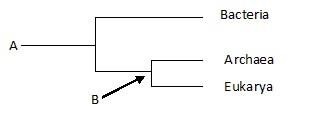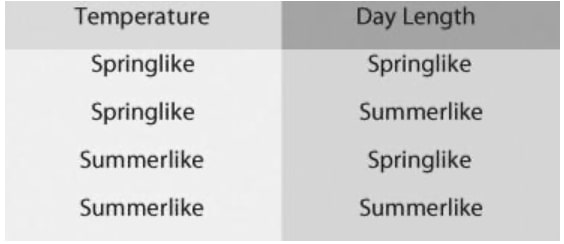- Chapter 1-Evolution, the Themes of biology, and Scientific Inquiry
1) Cells are .
A) only found in pairs, because single cells cannot exist independently
B) limited in size to 200 and 500 micrometers in diameter
C) characteristic of eukaryotic but not prokaryotic organisms
D) characteristic of prokaryotic and eukaryotic organisms
Answer: D
2) In comparison to eukaryotes, prokaryotes _.
A) are more structurally complex
B) are larger
C) are smaller
D) do not have membranes
Answer: C
3) Which of the following types of cells utilize deoxyribonucleic acid (DNA) as their genetic material but do not have their DNA encased within a nuclear envelope?
A) animal
B) plant
C) archaean
D) fungi
Answer: C
4) To understand the chemical basis of inheritance, we must understand the molecular structure of DNA. This is an example of the application of which concept to the study of biology?
A) evolution
B) emergent properties
C) reductionism
D) feedback regulation
Answer: C
5) A localized group of organisms that belong to the same species is called a .
A) community
B) population
C) ecosystem
D) family
Answer: B
6) Which of the following statements is FALSE regarding the complexity of biological systems?
A) An understanding of the interactions between different components within a living system is a key goal of a systems biology approach to understanding biological complexity.
B) Knowing the function of a component of a living system can provide insight into its structure and organizati
C) Understanding the chemical structure of DNA reveals how it directs the functioning of a living cell.
D) An ecosystem displays complex properties not present in the individual communities within it.
Answer: C
7) When a person gets dehydrated while exercising on a hot day, their pituitary gland releases
ADH, a hormone that signals the kidneys to retain more water. This is an example of
A) Positive feedback regulation
B) Negative feedback regulation
C) Chemical cycling
D) Emergent properties
Answer: B
8) Prokaryotes are classified as belonging to two different domains. What are the domains?
A) Bacteria and Eukarya
B) Archaea and Monera
C) Bacteria and Protista
D) Bacteria and Archaea
Answer: D
9) Which of these provides evidence of the common ancestry of all life?
A) near universality of the genetic code
B) structure of the nucleus
C) structure of cilia
D) structure of chloroplasts
Answer: A
10) Which branch of biology is concerned with the naming and classifying of organisms?
A) informatics
B) taxonomy
C) genomics
D) evolution
Answer: B
11) The phylogenetic tree below .

A) depicts the three major domains of life
B) includes unicellular but not multicellular life
C) includes unicellular and some forms of multicellular life, but not complex animals and plants
D) includes non-cellular life-forms
Answer: A
12) In the diagram below, “A” is ; “B” is .

A) the most recent species to evolve on Earth; an ancestor of group “A”
B) the most recent species to evolve on Earth; the last common ancestor of Archaea and Eukarya
C) the common ancestor of all life; the common ancestor of Bacteria and Archaea
D) the common ancestor of all life; the last common ancestor of Archaea and Eukarya
Answer: D
13) You find yourself standing next to a beautiful rose bush. Which of the following do you and the rose have in common?
A) You both are multicellular.
B) You both lack a membrane-bound nuc
C) You are both prokaryotic.
D) You and the rose have nothing in common.
Answer: A
14) Which of the following is (are) true of natural selection?
A) It requires genetic variation.
B) It results in descent with modificati
C) It involves differential reproductive succe
D) It requires genetic variation, results in descent with modification, and involves differential reproductive succes
Answer: D
15) Charles Darwin proposed a mechanism for descent with modification that stated that organisms of a particular species are adapted to their environment when they possess .
A) non-heritable traits that enhance their survival in the local environment
B) non-heritable traits that enhance their survival and reproductive success in the local environment
C) heritable traits that enhance their survival and reproductive success in the local environment
D) heritable traits that decrease their survival and reproductive success in the local environment Answer: C
16) Which of the following best describes what occurred after the publication of Charles
Darwin’s On the Origin of Species?
A) The publisher was pressured to cease dist
B) The book was banned from schools.
C) The book was widely discussed and dissemina
D) The book was discredited by most scientists.
Answer: C
17) Darwin’s finches, collected from the Galápagos Islands, illustrate which of the following?
A) mutation frequency
B) ancestors from different regions
C) adaptive radiation
D) vestigial anatomical structures
E) the accuracy of the fossil record
Answer: C
18) Cotton-topped tamarins are small primates with tufts of long white hair on their heads. While studying these creatures, you notice that males with longer hair get more opportunities to mate and father more offspring. To test the hypothesis that having longer hair is adaptive in these males, you should .
A) test whether other traits in these males are also adaptive
B) look for evidence of hair in ancestors of tamarins
C) determine if hair length is heritable
D) test whether males with shaved heads are still able to mate
Answer: C
The following experiment is used for the corresponding question(s).
A researcher discovered a species of moth that lays its eggs on oak trees. Eggs are laid at two distinct times of the year: early in spring when the oak trees are flowering and in midsummer when flowering is past. Caterpillars from eggs that hatch in spring feed on oak flowers and look like oak flowers. But caterpillars that hatch in summer feed on oak leaves and look like oak twigs.
How does the same population of moths produce such different-looking caterpillars on the same trees? To answer this question, the biologist caught many female moths from the same population and collected their eggs. He put at least one egg from each female into eight identical cups. The eggs hatched, and at least two larvae from each female were maintained in one of the four temperature and light conditions listed below.

In each of the four environments, one of the caterpillars was fed oak flowers, the other oak leaves. Thus, there were a total of eight treatment groups (4 environments × 2 diets).
19) Refer to the accompanying figure. Which one of the following is NOT a plausible hypothesis to explain the differences in caterpillar appearance observed in this population?
A) The longer day lengths of summer trigger the development of twig-like caterpillar
B) The cooler temperatures of spring trigger the development of flowerlike caterpillars.
C) Differences in air pressure, due to differences in elevation, trigger the development of different types of caterpillars.
D) Differences in diet trigger the development of different types of caterpillar
Answer: C
20) Refer to the accompanying figure. In every case, caterpillars that feed on oak flowers look like oak flowers. In every case, caterpillars that were raised on oak leaves looked like twigs. These results support which of the following hypotheses?
A) The longer day lengths of summer trigger the development of twig-like caterpillar
B) Differences in air pressure, due to elevation, trigger the development of different types of caterpillar
C) Differences in diet trigger the development of different types of caterpillar
D) The differences are genetic. A female will either produce all flowerlike caterpillars or all twig-like caterpillar
Answer: C
21) Refer to the accompanying figure. Recall that eggs from the same female were exposed to each of the eight treatments used. This aspect of the experimental design tested which of the following hypotheses?
A) The longer day lengths of summer trigger the development of twig-like caterpillar
B) Differences in air pressure, due to elevation, trigger the development of different types of caterpillar
C) Differences in diet trigger the development of different types of caterpillar
D) The differences are genetic. A female will either produce all flowerlike caterpillars or all twig-like caterpillar
Answer: D
22) Recall the caterpillar experiment in which caterpillars born in the spring looked like flowers, and caterpillars born in the summer looked like twigs. What is the most likely selective advantage for this difference in body shape?
A) Looking like their food sources allows the caterpillars to move through their environment more efficiently.
B) Development into the adult moth form is faster for caterpillars shaped like twigs than like flower
C) Looking like their food source lets the caterpillars blend into their surroundings, reducing predati
D) Looking like their food source will increase the caterpillars’ feeding efficiency; this would increase their growth rate and survival ra
Answer: C
23) How does a scientific theory differ from a scientific hypothesis?
A) Theories are proposed to test scientific hypotheses.
B) Theories are usually an explanation for a more general phenomenon; hypotheses typically address more specific issue
C) Hypotheses are usually an explanation for a more general phenomenon; theories typically address more specific issue
D) Confirmed theories become scientific laws; hypotheses become theories
Answer: B
24) A friend of yours calls to say that his car would not start this morning. He asks for your help. You say that you think the battery must be dead. If so, then jump-starting the car from a good battery will solve the problem. In doing so, you are .
A) testing a theory for why the car will not start
B) making observations to inspire a theory for why the car will not start
C) stating a hypothesis and using that hypothesis to make a testable prediction
D) comparing multiple hypotheses for why the car will not start
Answer: C
25) Agrobacterium infects plants and causes them to form tumors. You are asked to determine how long a plant must be exposed to these bacteria to become infected. Which of the following experiments will provide the best data to address that question?
A) Determine the survival rate of Agrobacterium when exposed to different concentrations of an antibiot
B) Measure the number of tumors formed on a plant when exposed to various concentrations of
Agrobacterium.
C) Measure the concentration of Agrobacterium in different soil environments where the plants gro
D) Measure the number of tumors formed on plants, which are exposed to Agrobacterium for different lengths of ti
Answer: D
26) Agrobacterium infects plants and causes them to form tumors. You determine that tumor formation requires a large amount of the plant’s energy for tissue formation. How might this change the number of offspring a plant produces, and what is the most likely explanation for this change?
A) The number of offspring should increase, because in general, illness increases the reproductive output of organism
B) The number of offspring should increase, because the bacteria will provide energy for the plant.
C) The number of offspring should decrease, because the plant will divert energy from reproduction to tumor for
D) There should be no effect of infection on offspring production because energy for reproduction is independent of infecti
Answer: C
Use the following information when answering the corresponding question(s).
In 1668, Francesco Redi performed a series of experiments on spontaneous generation. He began by putting similar pieces of meat into eight identical jars. Four jars were left open to the air, and four were sealed. He then did the same experiment with one variation: Instead of sealing four of the jars completely, he covered them with gauze (the gauze excluded the flies while allowing the meat to be exposed to air). In both experiments, he monitored the jars and recorded whether or not maggots (young flies) appeared in the meat.
27) Refer to the paragraph on Redi’s experiments. What hypothesis was being tested in the initial experiment with open versus sealed jars?
A) Spontaneous generation is more likely during the long days of summer
B) The type of meat used affects the likelihood of spontaneous generation
C) Maggots do not arise spontaneously, but from eggs laid by adult flies
D) Spontaneous generation can occur only if meat is exposed to air
Answer: C
28) Refer to the paragraph on Redi’s experiments. In both experiments, flies appeared in all of the open jars and only in the open jars. Which one of the following statements is correct?
A) The experiment was inconclusive because Redi used only one kind of mea
B) The experiment was inconclusive because it did not run long enough.
C) The experiment supports the hypothesis that spontaneous generation occurs in rotting mea
D) The experiment supports the hypothesis that maggots arise only from eggs laid by adult flies
Answer: D
29) The best experimental design .
A) includes a large sample size for each condition
B) includes a control
C) alters only one condition between the controls and the experimental condition
D) includes a large sample size and a control, and alters only one condition between the controls and the experimental condition
Answer: D
30) In the process of science, which of these is tested?
A) a result
B) an observation
C) a hypothesis
D) a control group
Answer: C
31) A controlled experiment .
A) is repeated many times to ensure that the results are accurate
B) includes at least two groups, one of which does not receive the experimental treatment
C) includes at least two groups, one differing from the other by two or more variables
D) includes one group for which the scientist controls all variables
Answer: B
32) Which of the following are qualities of any good scientific hypothesis?
I. It is testable.
II. It is falsified
III. It produces quantitative data.
IV. It produces results that can be replicate
A) I only
B) III only
C) I and II
D) III and IV Answer: C
33) In presenting data that result from an experiment, a group of students show that most of their measurements fall on a straight diagonal line on their graph. However, two of their data points are “outliers” and fall far to one side of the expected relationship. What should they do?
A) Do not show these points because clearly something went wrong in the experimen
B) Average several trials, rule out the improbable results, and do not show them in the final wor
C) Show all results obtained and then try to explore the reason(s) for these outlier
D) Change the details of the experiment until they can obtain the expected results
Answer: C
34) Which of the following is the best description of a control for an experiment?
A) The control group is kept in an unchanging environment.
B) The control group is matched with the experimental group except for one experimental varia
C) The control group is exposed to only one variable rather than severa
D) Only the experimental group is tested or measured.
Answer: B
35) Which of these is an example of inductive reasoning?
A) Hundreds of individuals of a species have been observed and all are photosynthetic; therefore, the species is photosynthetic.
B) These organisms live in sunny reg Therefore, they are using photosynthesis
C) If protists are all single-celled, then they are incapable of aggregating.
D) If two species are members of the same genus, they are more alike than each of them could be to a different genus.
Answer: A
36) The application of scientific knowledge for some specific purpose is known as .
A) technology
B) deductive science
C) inductive science
D) pure science
Answer: A
37) Which of the following best describes a model organism?
A) It is often pictured in textbooks and easy for students to imagine
B) It is well studied, it is easy to grow, and results are widely applicable
C) It is small, inexpensive to raise, and lives a long time.
D) It has been chosen for study by early biologists.
Answer: B
38) Why is a scientific topic best discussed by people of varying points of view, from different subdisciplines, and representing diverse cultures?
A) Robust and critical discussion between diverse groups improves scientific thinking.
B) Scientists can coordinate with others to conduct experiments in similar way
C) This is a way of ensuring that everyone gets the same result
D) People need to exchange their ideas with other disciplines and cultures because everyone has a right to an opinion in scienc
Answer: A

